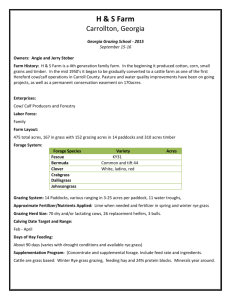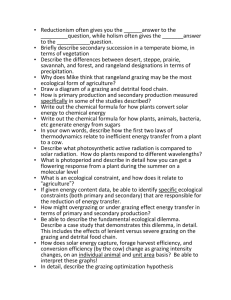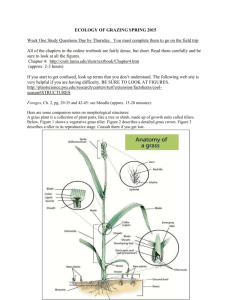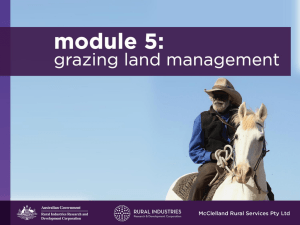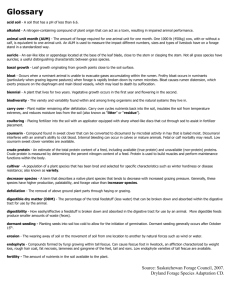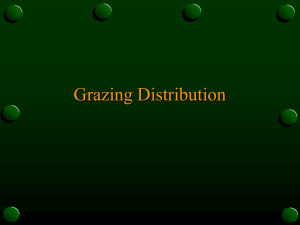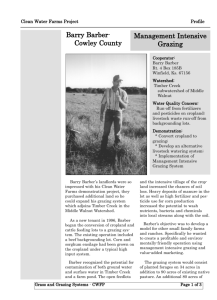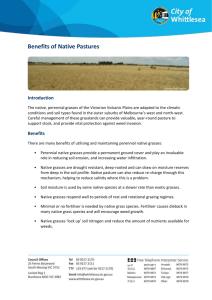Grass Growth and Pasture Management
advertisement
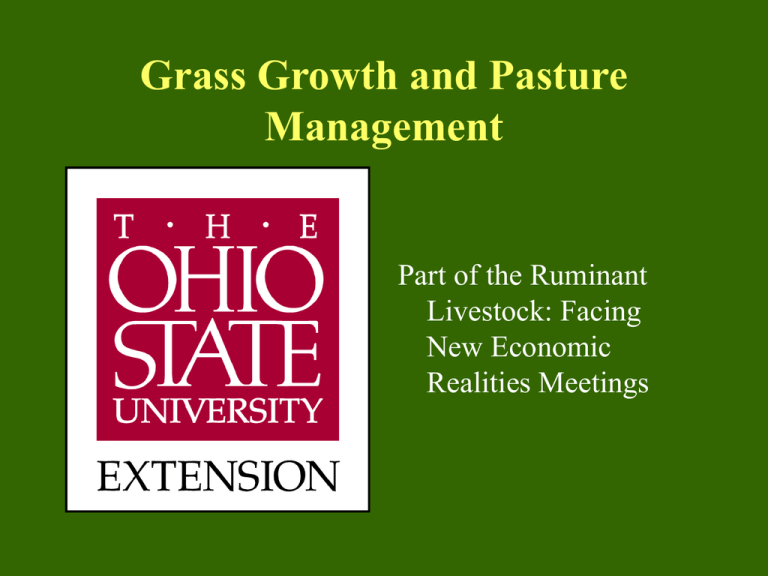
Grass Growth and Pasture Management Part of the Ruminant Livestock: Facing New Economic Realities Meetings Grass Plant Tillers Seed head Lead Tiller Crown Tiller Source: L.L. Manske North Dakota State University Rhizome Tiller Grass Physiology • Cool season grasses initiate flower buds on the crown when exposed to low temperatures and long nights. • Carbohydrates are stored late in the growing season (fall management is critical). • In the spring, new growth is initiated from the crown using carbohydrate reserves stored in the roots, rhizomes, stolens, and/or stem bases. • As day length increases throughout spring, at some point a flowering response is triggered. Grass Physiology • Not all tillers produced by the plant are reproductive tillers, but… • Because reproductive tillers grow taller than the vegetative tillers they shade out the vegetative tillers and in addition… • As seed heads develop they produce plant hormones that retard the development of other vegetative tillers Grass Physiology • Removing the seed head by grazing or clipping will promote development of vegetative tillers • Because most cool season grasses require cool temperatures and long nights to once again develop reproductive tillers, after seed heads are removed, vegetative growth is produced for the remainder of the year UNDERSTANDING PLANT GROWTH • • • • • Light Roots/Carbohydrate Reserves Temperature Water Fertility/Nutrients PLANT REGROWTH AFTER HARVEST • From Carbohydrates Produced by Remaining Leaf Area • From Carbohydrate Reserves Defoliation Stresses Forage Plants • Reduces or eliminates photosynthesis • Stops nutrient uptake from the soil • In legumes, nitrogen fixation stops within hours of harvest Leaf Removal vs. Root Growth 10% 20% 30% 40% % Leaf 50% Removed 60% 70% 80% 0 20 40 60 Percentage Root Growth Stoppage Source: Crider, 1955 80 100 Grazing Principle For Rapid Regrowth: Take Half Leave Half (By weight/volume: recognize forage is denser towards base of plant) What You Leave Behind… • • • • • Affects re-growth rate Affects root growth Affects soil temperature Affects organic matter Affects water infiltration rate and waterholding capacity • Affects nutrient cycling Animal Intake and Pasture Residual • Forage Systems Research Center work has found about 80% of the variation in grazing intake is correlated with post-grazing residual. • When forage mass drops below a critical level, intake is restricted • In other words, the reason the top end of graziers are getting better animal performance compared to lower end graziers is because they know when to get their livestock out of a pasture paddock. Managing Grazing Heights: Pure or dominant grass stands Species Pre-graze inches Perennial Ryegrass 6-7 Post-graze inches 3 Orchardgrass 8-10 3-4 T. Fescue (E+) 5-6 1-2 T. Fescue (E-) 8-10 3-4 Brome grass Pre or late jointing 2-3 Timothy Pre or late jointing 4 Managing Grazing Height Grass Legume Mixtures Species Pre-graze inches Post-graze inches Bluegrass/w clover 4-5 1-2 OG/L clover 6-8 2-3 T fescue/L clover 5-8 1.5 - 2 Alfalfa with grass bud 2-3 Red clover with grass bud 2-3 Grazing Principle •Provide plants with adequate rest period to re-grow to correct grazing height Relationship of rest period to pasture mass during periods of rapid vs. slow growth Optimum Lbs. Rest DM / acre Period 0 0 5 10 15 20 Period of fast plant growth (days) 10 20 30 40 Period of slow plant growth (days) 25 50 Source: Craig Saxe, University of Wisconsin Extension Rest Period Management • Paddock number determines flexibility and the degree to which the grass plant can be managed. • For example in a 4 paddock system if my goal is not to graze the new re-growth until 8 inches, then my rotation flexibility is 12-16 days in the spring and 28 to 32 days in the summer • In a 10 paddock system, rotation flexibility is 10 to 30 days in the spring and 50 to 70+ days in the summer • More paddocks can result in higher utilization rates MANAGEMENT TO OPTIMIZE PLANT GROWTH • Avoid production of seed heads, keep the plant vegetative • Maintain leaf canopy (residual management) • Recharge plant root reserves • Vary rest periods by season and rainfall • Frequent shifts of short duration • Provide adequate soil nutrients Growing Season Management • The reason behind using rest periods and residual management is to increase productivity and to put the grazier in the position to extend the grazing season through: • Quicker green up in the spring • Quicker recovery from drought • Fall/Winter grazing? Management Changes?

